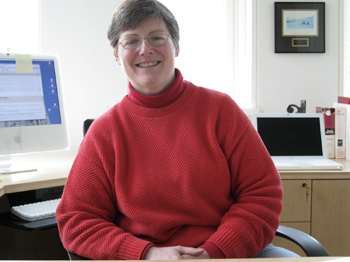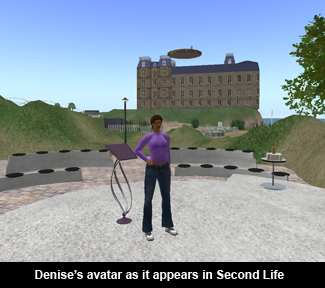Drama 337
 Taught by: Denise Walen
Taught by: Denise Walen
The Course
What is the course in which you use instructional technologies about?
Tell us about its origin, goals and objectives.
The course is a seminar in paratheater, which basically means that we study performance events that tend to fall outside a more traditional definition of theater. Over the years, the class has examined street theater and agit-prop events; we have looked at the performative aspects of the circus, standup comedy, rock concerts, television, sporting events, religious ceremonies, political/social/environmental demonstrations, tourism, and terrorism, and have analyzed the performative quality of race, class, and gender.
The course relies on performance theories that maintain that any human action, any event, may be analyzed as a performance, even though it may not be possible to define every event as being a performance. I developed the course when I first came to Vassar following the emergence of performance theory as a major new theoretical construct in the discipline of theater. The goal of the course is to encourage students to think critically about what constitutes a performance in contemporary society and to use performance as a lens to examine the broad social, political, and cultural contexts of events that surround them everyday.
The Technology
What were the technologies used and how did they change or enhance your course?
I used Second Life late in the semester during a section in which we focused on liveness within the performative event. As some theorists have argued that one of the primary characteristics of performance is its live quality, others have disputed the claim arguing instead that liveness is a nostalgic notion not suited to contemporary forms of performance, especially in our highly mediatized age. In the class, we put liveness to the test using Second Life. As online performance has grown in popularity, possibly because it blurs the distinction between performer and spectator and allows for an entirely new level of interaction, this section of the course has become increasingly important. We used to go into a chat room and create text-based online performances. Now the students virtually enter Second Life and perform both with and for each other.
The Student Response
How have your students responded to your use of this technology?
 On one hand, they seem to embrace it with gusto. After we have read theories of liveness and articles about online or computer based performances and gaming, I introduce the students to Second Life. Some of them are familiar with the site and one or two have had their own avatar, but this tends to be completely new technology for the majority of students. Each student is required to create an avatar for the next class and learn some gestural command. At the following class, we meet in Second Life and the avatars introduce themselves and teach us how to make the gesture they have learned. At the end of class, we see if we can determine which avatar belongs to which student. Given that the avatars the students create generally look nothing like them, and may represent a different gender or race, or might not even look human, this class is generally very entertaining. For the following class, they are put in pairs and are responsible for creating a short performance. On the other hand, while the students seem to have a good time in these classes, they tend to agree with the theorists who advocate for the live experience of performance. The interaction of the form holds little attraction for them and they chafe against the emotive distance they feel from their “audience.”
On one hand, they seem to embrace it with gusto. After we have read theories of liveness and articles about online or computer based performances and gaming, I introduce the students to Second Life. Some of them are familiar with the site and one or two have had their own avatar, but this tends to be completely new technology for the majority of students. Each student is required to create an avatar for the next class and learn some gestural command. At the following class, we meet in Second Life and the avatars introduce themselves and teach us how to make the gesture they have learned. At the end of class, we see if we can determine which avatar belongs to which student. Given that the avatars the students create generally look nothing like them, and may represent a different gender or race, or might not even look human, this class is generally very entertaining. For the following class, they are put in pairs and are responsible for creating a short performance. On the other hand, while the students seem to have a good time in these classes, they tend to agree with the theorists who advocate for the live experience of performance. The interaction of the form holds little attraction for them and they chafe against the emotive distance they feel from their “audience.”
The Challenges
What were the challenges you faced when teaching this course?
The challenges were many.
First, I had to teach myself about Second Life; or rather, relied on the expertise of Steve Taylor to get me into Second Life. Learning basic maneuvers such as how to walk, talk, fly, and wave took time. One day I embedded myself, well, my avatar, in the wall of Main on the Vassar Island and couldn’t get out. We also move these two classes over to the classroom in the library so that everyone has access to Second Life. I should also say that if traditional teaching is a challenge, trying to maintain a professional academic atmosphere when you are a virtual avatar is impossible. It’s amazing what students will do when they are disembodied, but given a whole new set of powers. These practical challenges are minor, though. The real challenge is to get the students to think about how computer technology changes the nature of performance and what it might have to offer theater majors in a mediatized age. The lure and appeal of the live is very strong. They can be resistant to this kind of major shift in their thinking about what constitutes a performance, how it extends the performativity of identity and the freedom and dangers inherent in that, and how interaction might replace voyeurism as the role of the spectator. In essence, they focus on what is lost in the move from traditional performance to this mediatized performance and find it difficult to identify instead what might be gained from the technology.
New Directions
What new directions would you like to explore with technology in your teaching?
At the moment, I don’t have any new directions I want to explore with technology. I approach technology as a support to what I teach rather than the driving force and tend to come upon it either haphazardly or as a solution to a particular problem. For example, a course I teach every year has an unusually and extremely large enrollment this year. While we try to maintain an open discussion format, it is difficult for all the students to participate all the time. To help provide them with a forum for their ideas about the plays we are reading, I activated the discussion board feature on our blackboard site and the students are slowing finding their way to it.
